Filmmaking is a form of art that has the power to captivate and move audiences. With the rise of digital technology, it has become more accessible to aspiring filmmakers to bring their vision to life. However, one of the biggest obstacles to overcome is the cost of equipment, especially cameras.
Finding the right camera for your film project can be a daunting task, especially when you’re on a tight budget. Fortunately, you don’t have to sacrifice quality for affordability. In this article, we’ll explore the best camera options for filmmaking on a budget and provide you with the information you need to make an informed decision.
- The Importance of Image Quality
- Budget-Friendly Cameras for Filmmaking
- Key Features to Consider in a Camera for Filmmaking
- The 8 Best Camera for Filmmaking on a Budget
- 1. Panasonic LUMIX FZ80 4K Digital Camera
- 2. Sony Alpha a6000 Mirrorless Digital Camera
- 3. Sony Alpha a6000 Mirrorless Camera with 16-50mm and 55-210mm Lenses Bundle
- 4. Olympus OM-D E-M10 Mark II Mirrorless Camera
- 5. Fujifilm X-T2 Mirrorless Digital Camera
- 6. Fujifilm X-T3 Mirrorless Digital Camera
- 7. Sony DSCHX80/B High Zoom Point & Shoot Camera
- 8. Canon PowerShot G9 X Mark II Compact Digital Camera
- Comparison of Top Budget Filmmaking Cameras
- Factors to Consider When Choosing a Camera for Filmmaking on a Budget
- What to Expect from Budget Filmmaking Cameras
- Conclusion
- Frequently Asked Questions
The Importance of Image Quality
Image quality is one of the most important factors to consider when choosing a camera for filmmaking. You want a camera that can produce high-quality images, with good color accuracy, sharpness, and low noise. The quality of the image can greatly affect the overall look and feel of your film, so it’s important to choose a camera that can deliver the results you need.
Budget-Friendly Cameras for Filmmaking
There are several budget-friendly cameras that are ideal for filmmaking. Here are some of the best options:
- Sony Alpha a7S II
- Panasonic Lumix GH5
- Canon EOS R6
- Blackmagic Pocket Cinema Camera 4K
- Fujifilm X-T4
Each of these cameras offers different features and capabilities, and the best one for you will depend on your specific needs and budget.
Key Features to Consider in a Camera for Filmmaking
When it comes to choosing a camera for filmmaking, there are several key features to consider. Here are five important ones to keep in mind:
- Resolution: The resolution of a camera determines the detail and clarity of the images it captures. A higher resolution means more detail and sharper images, which is important for creating high-quality films.
- Dynamic Range: Dynamic range refers to the ability of a camera to capture detail in both bright and dark areas of a scene. A camera with a high dynamic range will produce more balanced and natural-looking images, which is important in filmmaking.
- Low Light Performance: Filmmaking often takes place in various lighting conditions, so it’s important to choose a camera that performs well in low light. A camera with good low light performance will produce clearer images with less noise and grain, even in dimly lit scenes.
- Interchangeable Lenses: Interchangeable lenses allow you to choose different lenses for different types of shots, which is important for creative control and flexibility in filmmaking. Different lenses offer different focal lengths, apertures, and other features, so having the option to change lenses can be a major advantage.
- Manual Controls: Manual controls give you more control over the camera’s settings, such as shutter speed, ISO, and aperture. This allows you to fine-tune your shots and achieve the look you want, which is critical in filmmaking.
These are some of the key features to consider when choosing a camera for filmmaking. By taking these factors into account, you can choose a camera that will help you create high-quality, professional-looking films.
The 8 Best Camera for Filmmaking on a Budget
1. Panasonic LUMIX FZ80 4K Digital Camera
Panasonic presented the LUMIX FZ80 4K Point and Shoot Long Zoom Camera at CES 2017, nearby its other new models. The FZ80 isn’t as extravagant as the GH5 and the GX850, however, it has grabbed the attention of many simple to use lovers due to its fascinating highlights and reasonable value point. Nonetheless, the inquiry is this: would it be able to satisfy desires and give purchasers their cash value?
The Panasonic LUMIX FZ80 4K Point and Shoot Long Zoom Camera accompanies a 0.2-inch 1,170K-dab electronic viewfinder, which furnishes you with a reasonable and definite perspective regarding your matter and encourages you to take the most ideal shots. The camera likewise has a 3-inch back LCD show with a 1,040K-spot goal. The showcase is touchscreen-empowered, making it simple for you to set center focuses and discharge the shade.
Taking clear photographs and recordings is simple with the FZ80’s 1/2.3-inch MOS sensor, which has a powerful goal of 18.1 MP. This is matched with the LUMIX DC VARIO focal point, which has an optical zoom of 60x that can be raised to 120x computerized zoom through Panasonic’s Intelligent Zoom innovation. This amazing zoom ability — combined with the FZ80’s quick LUMIX DFD centering framework and fast burst shooting capacity — enables you to effectively catch faraway or potentially brisk moving subjects.
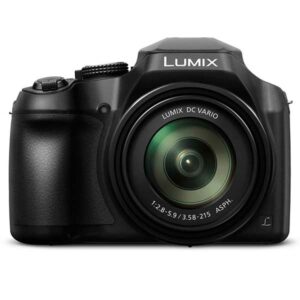
Features:
- 1MP 1/2.3″ MOS Sensor
- 60x, 20-1200mm F2.8-5.9 zoom lens LUMIX DC VARIO
- 4K (3840 x 2160p) at 30 fps/ 4K photo mode
- ISO 80-6400 (Extended), 10 fps Continuous Shooting
- 0″ 1040k-dot TFT Screen LCD Display
- 20″ 1,166k-dot Live View Finder
- LUMIX DFD (Depth From Defocus) focusing system
- It comes with 4K-centric features
- It’s great for long-distance shooting
- It offers manual controls
- It’s easy on the wallet
- It’s a bit bulky
- It doesn’t have the features of its more advanced cousins
2. Sony Alpha a6000 Mirrorless Digital Camera
The A6000 is a camera that will endure a couple of tumbles. The body is smaller, however, it has a fantastic metal form which implies that it ought to endure a couple of extreme photography outings and turn out looking all-around great. The A6000 model accompanies an OLED electronic viewfinder, full-size hot shoe, committed mode dial and spring up the blaze.
There’s likewise a 3-inch, 921k-speck, tilting LCD, and a 24.7-megapixel CMOS sensor, WiFi, 1080/60p video and a top affectability of ISO 51,200. This camera has nearly all that you’d anticipate. The A6000 isn’t the scariest camera available, however, it has a couple of catches and dials that may appear to be threatening to amateurs. There’s a wheel mounted on the top that gives you a chance to pick your shooting mode. The auxiliary dial enables you to alter the opening and screen speed.
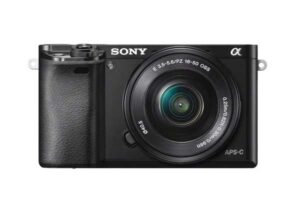
Features:
- 24MP – APS-C CMOS Sensor
- ISO 100 – 25600( expands to 51200)
- 3″ Tilting Screen
- 1440k dot Electronic viewfinder
- 11 fps continuous shooting
- 1920 x 1080 video resolution
- Built-in Wireless
- 120 x 67 x 45 mm
- Fast autofocus
- User-friendly interface
- Great image quality
- No external microphone port
- The small screen that’s impractical for shooting stills
- The screen is calibrated differently than the viewfinder which can be confusing
3. Sony Alpha a6000 Mirrorless Camera with 16-50mm and 55-210mm Lenses Bundle
The Sony Alpha a6000 is ostensibly the best mirrorless camera under 1000. This fantastic advanced camera offers an inconceivable cluster of highlights that work together to guarantee you can catch premium quality pictures and record predominant quality recordings or clasps. Highlights incorporate yet not restricted to; 24 MP APS-C sensor, moment self-adjust with 179 AF focuses, and 11FPS in addition to full HD 1080/24/60p video recording in a hurry. The high-goals Alpha camera from Sony likewise brags an ISO go 100-25600 for low light photography.
Likewise incorporated into the case are; SanDisk Ultra 128GB SD card, Tiffen 40.5mm UV Protector focal point channel, and 16-50 mm focal point (Black). Additionally, you likewise get a Sony E 55-210 mm f/4.5-6.3 OSS E-Mount Lens (Black), 40.5mm 3-Piece Lens Filter Kit, and Sony NP-FW50 Wasabi battery pack with two batteries. The item likewise accompanies a solitary double charger, one 12-Inch creepy-crawly tripod and a Corel Software Kit, including PaintShop X9/VideoStudio X9/AfterShot 3/Painter Essentials 5. The equipment is pressed inside an adorable camera pack by Focus.
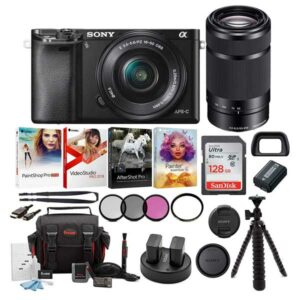
Features:
- 24MP – APS-C CMOS Sensor
- ISO 100 – 25600( expands to 51200)
- 3″ Tilting Screen
- 1440k dot Electronic viewfinder
- 11 fps continuous shooting
- 1920 x 1080 video resolution
- Built-in Wireless
- 120 x 67 x 45 mm
- Fast autofocus
- User-friendly interface
- Great image quality
- No external microphone port
- The small screen that’s impractical for shooting stills
- The screen is calibrated differently than the viewfinder which can be confusing
4. Olympus OM-D E-M10 Mark II Mirrorless Camera
Olympus has constantly intrigued with its OM-D line of mirrorless cameras. They include chic, retro-roused styling, great ergonomics, coordinated EVFs, and front line highlights. The OM-D E-M10 Mark II ($649.99, the body just) keeps that custom alive regarding imaging—unfortunately a body this smaller highlights a 5-pivot adjustment framework. It likewise incorporates an enormous, sharp EVF and incredible Wi-Fi execution.
Yet, it discards the 4K recording capacity offered by opponent Panasonic’s G7. The Alpha 6000 is a more established model (it also excludes 4K), however, it remains our Editors’ Choice for filmmaking cameras on a budget.
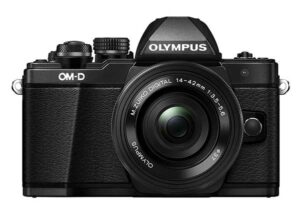
Features:
- Megapixels: 16
- Type: ILC/Mirrorless Micro Four Thirds
- Shots per sec: Up to 8.5fps (fixed focus and exposure); 4fps (AF/AE)
- Sensor type: 4/3 Live MOS Sensor
- AF points: 81-area multiple AF
- Shutter speed range: 1/4000-60 sec, Bulb
- ISO range: 200-25,600 (Auto ISO to a low of 100)
- Compact, but comfortable to use.
- Large, sharp EVF.
- Tilting touch-screen display.
- 6fps continuous shooting.
- Built-in flash.
- 5-axis stabilization system.
- Wi-Fi.
- Accurate tracking requires a slower burst rate.
- Wacky power switch.
- No mic input.
5. Fujifilm X-T2 Mirrorless Digital Camera
The X-T2 has rapidly turned out to be prominent among the proprietors of other Fujifilm cameras since it’s compatible with the broad scope of elite tradable focal points from the organization. It doesn’t make a difference in case you’re into road photography, scenes, or you shoot weddings professionally, with the correct focal point, the X-T2 can do everything.
The camera’s new self-adjust instrument uses improved calculations to all the more likely handle low-balance articles and subjects with sensitive subtleties, similar to fowl quills and creature hide. In case you’re accustomed to forming pictures utilizing a viewfinder, you’ll be satisfied to realize that the viewfinder on the X-T2 has an amplification proportion of 0.77x, helping you become one with your camera.
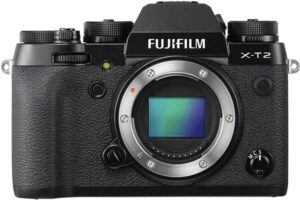
Features:
- New Firmware Ver.4.10
- X-Trans CMOS III & X-Processor Pro
- Improved AF Performance
- AF-C Custom Setting
- EVF (Magnification ratio 0.77x, Shutter time lag 0.005 sec, 100fps live-view)
- 4K Video Recording
- Optional Vertical Power Booster Grip
- Weather-resistant structure
- Fast and reliable autofocus.
- Large electronic viewfinder.
- Great low-light performance.
- Ergonomic design.
- Doesn’t support touch input.
6. Fujifilm X-T3 Mirrorless Digital Camera
While Full Frame mirrorless cameras have unquestionably ruled the discussion starting late, with apparently every major computerized camera producer available declaring or discharging new Full Frame mirrorless cameras, Fujifilm is maintaining their emphasis on their yield sensor camera bodies with the arrival of their new Fujifilm X-T3. Bragging noteworthy enhancements in wording highlights just as execution, the Fujifilm XT3 is focusing on picture takers and videographers alike that are searching for a strong workhorse camera in a smaller bundle.
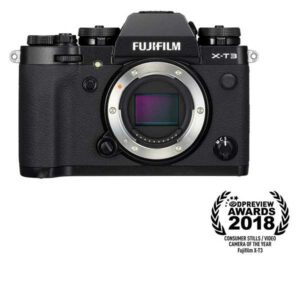
Features:
- New Firmware Ver.3.00
- X-Trans CMOS 4 & X-Processor 4
- Phase detection AF to the entire frame
- Up to 30 fps black-out free high-speed continuous shooting
- Sports finder mode
- Monochrome Adjustment
- Color Chrome Effect
- 4K/60P 10-bit recording
- Weather-resistant structure
- Excellent weather sealing
- Very solid build quality
- Excellent image quality
- Versatile RAW files
- Amazing video capabilities
- Battery life can use some improvement
- Lacks in-body image stabilization
7. Sony DSCHX80/B High Zoom Point & Shoot Camera
The core of the Sony HX80 is the 1/2.3″ CMOS sensor that estimates 7.82mm x 4.55mm. Sony has a lot of involvement in assembling progressed computerized sensors that are utilized in their very own cameras, just as other significant brands. Subsequently, the sensor in the HX80 is the very best in class and offers amazing picture quality in a wide assortment of lighting conditions. Pictures are caught at a goal of 18.2 megapixels, which is truly good for a conservative camera.
The fantastic picture quality in the HX80 is additionally due to the superb Zeiss Vario-Sonnar T Optical Zoom focal point that has the greatest gap scope of f/3.5-6.4.
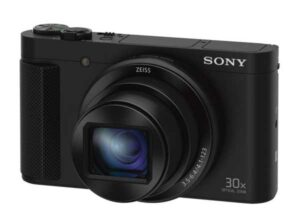
Features:
- 18MP – 1/2.3″ BSI-CMOS Sensor
- ISO 80 – 3200( expands to 12800)
- 24-720 mm F3.5-6.4 Zoom Lens
- 5-axis Optical Image Stabilization
- 3″ Tilting Screen
- Electronic viewfinder
- 0 fps continuous shooting
- 1920 x 1080 video resolution
- Built-in Wireless
- 102 x 58 x 36 mm
- Built-in Wireless (Wi-fi)
- NFC Connectivity
- 5-axis Image Stabilization
- Articulating Screen
- 1920 x 1080 Max Video Resolution
- No External Flash Shoe
- No Touch Screen
- No RAW Shooting
8. Canon PowerShot G9 X Mark II Compact Digital Camera
Sometime in the distant past, Canon was the undisputed market pioneer in smaller cameras for genuine picture takers. In 2012, in any case, Sony flipped around the market with its Cyber-shot DSC-RX100. The main camera with a 1-inch, 20MP sensor, it totally re-imagined desires for the picture quality reachable from reduced cameras.
Standard was the principal producer to challenge Sony in this new part, yet its initial models including the first PowerShot G9X utilized genuinely underpowered processors. Be that as it may, presently the firm has embraced its most recent, a lot quicker Digic 7 processor, which vows to transform the refreshed Mark II variant into a considerably more alluring choice.
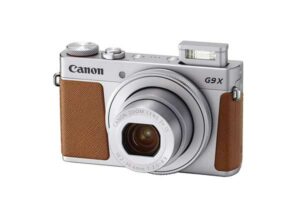
Features:
- 2MP 1in sensor
- 28-84mm equivalent f/2-4.9 lens
- ISO 125-12,800
- 2 fps continuous shooting
- 3in, 1.04-million-dot-resolution touchscreen
- Slimline, pocketable design
- Good image quality from the 1-inch sensor
- Well-implemented touchscreen
- The excellent in-camera JPEG processing
- Unambitious lens
- Limited physical controls
- No 4K video recording
Comparison of Top Budget Filmmaking Cameras
Here is a comparison of some of the top budget filmmaking cameras based on the key features to consider:
| Camera | Resolution | Dynamic Range | Low Light Performance | Interchangeable Lenses | Manual Controls |
|---|---|---|---|---|---|
| Canon EOS M50 Mark II | 24.1 MP | 13 stops | Good | Yes | Partial |
| Sony a6400 | 24.2 MP | 14 stops | Excellent | Yes | Full |
| Panasonic Lumix GH5 | 20.3 MP | 12 stops | Good | Yes | Full |
| Fujifilm X-T30 | 26.1 MP | 14 stops | Good | Yes | Full |
| Nikon Z50 | 20.9 MP | 12 stops | Good | Yes | Full |
Each of these cameras has its strengths and weaknesses, and the best choice will depend on your specific needs and preferences. The Canon EOS M50 Mark II offers good resolution and low light performance, but only partial manual controls. The Sony a6400 has excellent low light performance and full manual controls, but a slightly lower dynamic range. The Panasonic Lumix GH5 and Fujifilm X-T30 both offer good resolution and dynamic range, as well as full manual controls. The Nikon Z50 has good low light performance and full manual controls, but a slightly lower resolution and dynamic range compared to some of the other cameras.
It’s important to note that these are just a few of the many budget filmmaking cameras available, and there may be other options that suit your needs better. It’s always a good idea to research and compare different cameras before making a purchase.
Factors to Consider When Choosing a Camera for Filmmaking on a Budget
- Image Quality: The image quality of your camera is essential for creating a professional-looking film. Look for cameras that offer high-quality image sensors and the ability to shoot in 4K.
- Autofocus: Autofocus is crucial for filmmakers who want to capture fast-moving action. Look for cameras that offer fast and accurate autofocus systems.
- Video Recording Capabilities: Look for cameras that offer 4K video recording capabilities, as well as slow-motion and time-lapse options.
- Budget: Set a budget for your camera and stick to it. Remember, you don’t have to spend a lot of money to get a high-quality camera for filmmaking.
What to Expect from Budget Filmmaking Cameras
When it comes to budget filmmaking cameras, there are a few things you can expect:
- Limited Features: Budget filmmaking cameras typically have fewer features and capabilities than high-end cameras, but they still offer enough functionality to create professional-looking films.
- Compromises in Image Quality: While budget filmmaking cameras offer good image quality, there may be some compromises compared to more expensive cameras. For example, they may have lower resolution, dynamic range, and low light performance. However, these compromises may not be noticeable in most situations, especially if you’re just starting out with filmmaking.
- Interchangeable Lenses: Many budget filmmaking cameras offer the ability to use interchangeable lenses, which is an important feature for creative control and flexibility.
- Manual Controls: Many budget filmmaking cameras have manual controls, which allow you to fine-tune your shots and achieve the look you want. However, the level of manual control may be limited compared to more expensive cameras.
- Affordable Price: The main advantage of budget filmmaking cameras is their affordable price, which makes them a great option for aspiring filmmakers and those on a tight budget.
In conclusion, budget filmmaking cameras offer a good balance of features, image quality, and affordability. While they may not have the same capabilities as high-end cameras, they provide enough functionality to create professional-looking films, making them a great option for those just starting out or working with limited resources.
Conclusion
Filmmaking on a budget doesn’t have to mean sacrificing quality. With the right camera, you can create professional-looking films that will bring your vision to life. Whether you’re a seasoned filmmaker or just starting out, the Canon EOS M50 Mark II, Panasonic Lumix GH5s, and Sony A7 III are all excellent camera options for those on a budget. Consider your specific needs and budget, and choose the camera that’s right for you. Unleash your filmmaking potential and make your big break today with the best camera for filmmaking on a budget!